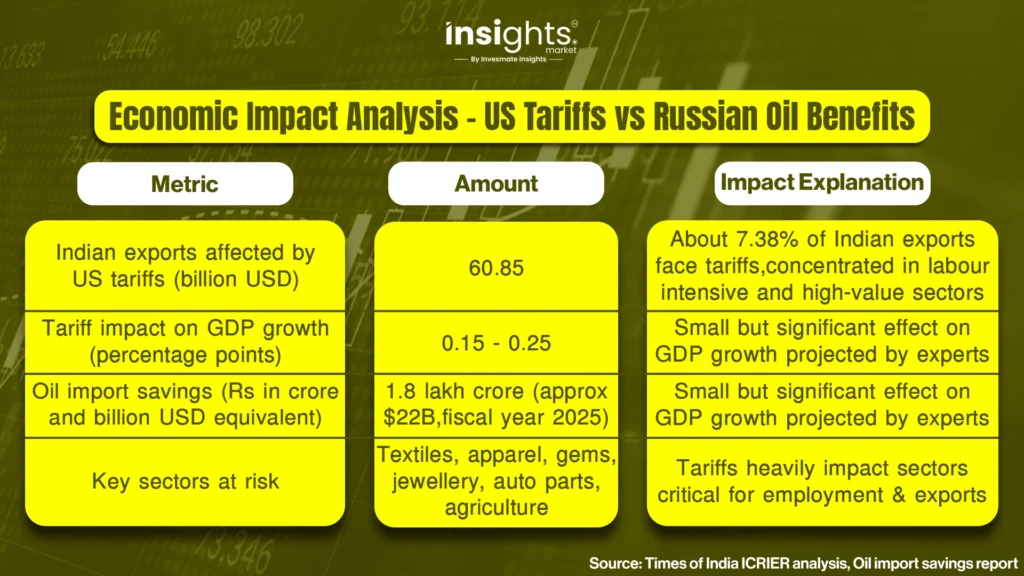![]()
On August 15, 2025, Alaska’s icy tundra unexpectedly became the center of global diplomacy. At Joint Base Elmendorf-Richardson in Anchorage, land that once belonged to Russia, U.S. President Donald Trump and Russian President Vladimir Putin shook hands on a red-carpet runway surrounded by fighter jets. The symbolism was impossible to miss: America and Russia, meeting on ground tied to their shared history, with the world watching closely.
But halfway across the globe, India saw this summit not just as another high-level meeting—but as a turning point that could directly decide its economic stability and energy security.
Why India Paid Close Attention to Alaska
For Putin, this was a comeback moment. After years of being sidelined following the Ukraine war, he was back on Western soil. For Trump, it was a global stage to showcase his deal-making style. But for India, the stakes were far higher—because what came out of this summit could affect over $87 billion in trade with the U.S. and crucial access to Russian oil.
When India’s Ministry of External Affairs said New Delhi “welcomed” the Trump-Putin talks, the statement was more than diplomatic courtesy. It carefully signaled India’s hope that any easing of tensions might reduce the economic pressure it currently faces. India depends heavily on both Washington and Moscow, and this summit could tilt that balance.
Imagine India’s position as a tightrope walker: on one end lies its booming trade ties with America, its largest export market, and on the other, discounted Russian oil, the lifeline of its energy security. A single misstep could send the economy crashing
The Energy Lifeline That Changed Everything
The real reason this summit mattered to India? Oil!
India imports over 85% of its crude requirements. A spike in global prices can ripple instantly through household budgets—from petrol pumps to cooking gas cylinders.
Before the Ukraine invasion in 2022, Russian oil barely figured in India’s imports. By 2025, it supplied over 40% of India’s crude, about 2.08 million barrels a day—worth nearly $53 billion annually. These cheaper imports saved India almost $19 billion in 2024 alone, money that funded development projects and cushioned inflation for ordinary families.

But this lifeline did not come without consequences.
The Trump Tariffs: India’s Economic Squeeze
In early August 2025, Trump announced a punishing 50% tariff on Indian exports—the steepest against any nation. His reasoning? India’s massive Russian oil purchases, which Washington viewed as undermining U.S. security interests.

The human cost was immediate:
- Textile units in Tamil Nadu feared losing U.S. buyers.
- Diamond polishers in Gujarat faced cancelled orders.
- Leather artisans in Uttar Pradesh worried about layoffs.
With $35 billion worth of Indian exports at risk, entire livelihoods are now hanging by a thread.
And the pressure didn’t stop there. U.S. Treasury Secretary Scott Bessent warned: if the Alaska meeting failed, secondary sanctions—even harsher penalties—could follow. For India, this meant its economic stability was tied directly to Trump’s conversations with Putin.
The August 27 Deadline and Trump’s Mixed Signals
Adding to New Delhi’s unease, Trump left the door open for even tougher measures. Speaking en route to Alaska, he said:
“India was buying nearly 40% of Russia’s oil. If I impose what’s called secondary sanctions, it would be devastating for them. Maybe I’ll do it, maybe I won’t.”
This meant New Delhi had just days until August 27, 2025—the rumored activation date for possible secondary tariffs. A prolonged trade standoff risked billions in exports, jobs, and investments.
Meanwhile, negotiations for a U.S.-India Bilateral Trade Agreement were abruptly postponed, worsening uncertainty.
India’s Strategic Balancing Act

Faced with this crisis, India turned to its trademark foreign policy approach: strategic autonomy.
Prime Minister Narendra Modi spoke to leaders on both sides of the Ukraine war—Ukraine’s President Zelenskyy and Russia’s Vladimir Putin—keeping India’s unique role as a potential peace broker alive.
Unlike most nations, India still maintains open channels to both Moscow and Washington while also engaging China through BRICS and America through the Quad. This multi-alignment strategy gives New Delhi more room to maneuver compared to countries forced to pick sides.
As Modi has repeatedly said, India is “not neutral, but on the side of peace.” This subtle distinction strengthens India’s credibility if real peace talks ever emerge.
The Summit Ends: Uncertainty, but Hope
The Trump-Putin meeting in Anchorage ended without a dramatic breakthrough—no ceasefire, no grand deal. In fact, both leaders left earlier than expected.
Yet for India, the silver lining was in Trump’s tone afterward. He hinted he might hold back on harsher tariffs if his strategy worked. For Indian policymakers, even that small window of flexibility provided breathing space.
Former Indian ambassador Ajay Bisaria called it “reassuring,” noting that there was no immediate escalation. For the moment, India could continue walking its tightrope.
The Numbers That Keep India Awake

- Exports at Risk: $30–35 billion annually if U.S. tariffs remain.
- Oil Savings: $19 billion saved in 2024 by buying Russian crude.
- Capital Flows: $4 billion already pulled out of Indian markets amid uncertainty.
For millions of Indians, these numbers translate into daily struggles—higher cooking gas costs, fuel price shocks, fewer jobs in export-driven industries, and a weaker rupee.
Beyond Oil: India’s Long-Term Energy Strategy
While Russian oil is today’s necessity, India is building a future beyond fossil fuels. It has already achieved 235+ GW of non-fossil capacity by mid-2025 and aims for 500 GW by 2030. Solar, wind, and nuclear are slowly reducing India’s dependency on volatile crude markets.
What does it mean for the Indian Stock Market?
Big political meetings between world powers create clear patterns. Indian investors see these patterns often. When the U.S. and Russia have conflicts, it affects India’s trade ties. This creates predictable market moves. Stocks that move first are often Energy companies that feel the impact first. Oil and gas stocks swing wildly. Investors worry about oil supply changes. Companies that import crude oil see big price moves.
Export businesses also react fast. IT companies, textile makers, and drug firms with U.S. clients watch every news update. Their stock prices jump up and down with each headline.
World events create short-term market chaos. But markets usually calm down fast. The key is managing risk well. Keep position sizes small. Stay ready to buy when good stocks get too cheap.
This is for learning only. It’s not investment advice.
Final Word
The Alaska summit may not have produced dramatic headlines, but for India, it reinforced a clear lesson: global diplomacy is never abstract—it directly shapes everyday life for its 1.4 billion people.
India’s challenge is to keep pursuing cheap energy, protect its booming trade with the U.S., and simultaneously uphold its role as a peace-broker on the world stage.
Its success now lies in how skillfully it can balance between superpowers without losing grip on its own economic future.
FAQs
Any thaw in U.S.–Russia tensions could ease tariff risks on Indian exports and stabilize crude prices. This would benefit sectors like textiles, autos, and oil-marketing companies (OMCs), potentially boosting benchmark indices such as Nifty 50 and Sensex.
About 7.4% of India’s total exports—worth roughly ₹5 trillion—are already subject to a 50% tariff. While the broader market impact may remain contained, any expansion of the tariff list could hurt India’s labour-intensive export sectors and earnings momentum.
Oil-marketing companies (IOC, BPCL, HPCL), along with airlines, logistics, and paint manufacturers, gain the most since cheaper crude lowers fuel and input costs, directly supporting profit margins.
A shift back to Middle-East crude at spot prices would raise feedstock costs, compressing refining margins. As a result, PSU refiners could underperform benchmark indices.
India saved about ₹1.8 lakh crore (approximately $22 billion) in FY 2025 from Russian discounts and lower global benchmark prices. These savings supported the current-account balance and helped stabilize the Indian rupee.
Yes. With non-fossil fuel capacity already at 235 GW and a 2030 target of 500 GW, renewable plays like NTPC Green, Adani Green, and JSW Energy provide structural hedges against oil volatility.
A wider goods trade deficit and foreign portfolio outflows could push the rupee toward 85–86 per U.S. dollar. RBI intervention and global oil price trends will be crucial in determining its stability.
By maintaining diversified ties with the U.S., Russia, BRICS, and the Middle East, India reduces dependence on any single partner. This hedging strategy supports long-term resilience in Indian equities.
If U.S.–Russia relations ease, CAATSA sanctions risks may decline, ensuring smoother Russian defence equipment supplies. This could act as a catalyst for stocks like HAL, BEL, and Bharat Dynamics.
Traders should track Nifty 50 support at 22,000 and resistance at 22,750. If crude stays below $80 per barrel, a breakout is possible, though fresh tariff headlines could trigger profit booking.




